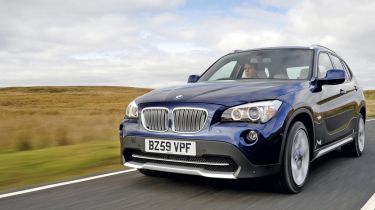BMW X1
How does BMW’s new small, all-diesel SUV range shape up on British roads?

Think of the X1 as a 3-Series Touring with more practicality and added value for money, and it begins to make sense. Compact dimensions and superb steering mean it’s great to drive, while an ultra-efficient diesel-only engine line-up keeps costs down. The half-SUV, half-coupé styling takes a bit of getting used to, yet the proportions are spot-on. Four-wheel-drive versions have excellent traction and stability in the wet, as well as limited off-road ability. But for the most part, the cheaper, more economical and faster rear-wheel-drive models are as good and better to drive.
BMW is carving out yet another niche! Following in the tracks of the innovative X5, X3 and X6, the all-new X1 shrinks the ‘X’ car philosophy into a more compact and affordable package. It also marks a first for the maker, as the engine line-up is exclusively diesel. We took the X1 for its debut on UK roads.
Designed as a more rugged alternative to the 3-Series Touring, and a sleeker substitute for the soon-to-be-replaced X3, the new car can name only the Infiniti EX37 and VW Tiguan as direct rivals. But with the Audi Q3 and Range Rover LRX on the horizon, it won’t have things all its own way for long.
Used - available now
Video: watch CarBuyer's video review of the BMW X1
[[{"type":"media","view_mode":"content_narrow","fid":"68468","attributes":{"alt":"","class":"media-image"}}]]
The X1’s lines are a blend of boxy off-roader and curvaceous coupé. Cues from the X3 and X5, such as short overhangs and squared-off wheelarches, are carried over, but a low roofline and elongated bonnet give the car a look all of its own.
The interior feels well made and durable. You sit low in the cockpit, but with a high sightline – what BMW calls the semi-command position. There’s lots of room, too, with space for five people and, with the rear seats folded, a 1,350-litre load area.
Three diesels are offered – or, to be precise, the same 2.0-litre four-cylinder unit tuned to three different levels. There’s a choice of 141bhp 18d and 175bhp 20d models, and both these turbos come with rear-wheel-drive or 4WD – badged sDrive and xDrive respectively.
sDrive cars are £1,305 cheaper, and as they weigh 85kg less, they deliver better fuel economy, emissions and performance. It’s no surprise that BMW expects these to outsell the xDrive versions.
We drove the flagship twin-turbo xDrive 23d, which offers 201bhp and 400Nm of torque. Performance is as strong as the figures suggest, although our car’s six-speed auto numbed the experience. We’d stick with the more involving manual – which also has stop-start as standard.
Where the X1 really comes alive, though, is in corners. The steering is loaded with feel and inspires you to explore the incredible grip available. Body roll is kept in check by a firm suspension set-up, and for a car of this size, refinement at motorway speeds is excellent.
Rear-wheel-drive versions feel more sprightly through bends, and grip nearly as well. Considering that the X1 will spend 99 per cent of its time on tarmac, we’d save the cash and go for one of these with a manual box – which is when the BMW starts to represent excellent value for money.
Rival: Infiniti EX37
While similar in size to the X1, the EX will be limited in the UK by its petrol-only line-up. It’s a niche choice – but with a detuned version of the Nissan 370Z’s 3.7 V6, firm suspension and responsive steering, it’s surprisingly sporty to drive.










